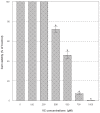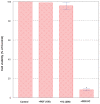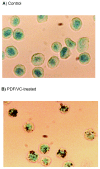Synergistic potentiation of D-fraction with vitamin C as possible alternative approach for cancer therapy
- PMID: 20360893
- PMCID: PMC2840554
- DOI: 10.2147/ijgm.s5498
Synergistic potentiation of D-fraction with vitamin C as possible alternative approach for cancer therapy
Abstract
Maitake D-fraction or PDF is the bioactive extract of maitake mushroom (Grifola frondosa) and its active constituent is the protein-bound polysaccharide (proteoglucan), or more specifically known as beta-glucan. PDF has been extensively studied and a number of its medicinal potentials/properties have been unveiled and demonstrated. Those include various physiological benefits ranging from immunomodulatory and antitumor activities to treatment for hypertension, diabetes, hypercholesterolemia, viral infections (hepatitis B and human immunodeficiency virus), and obesity. Particularly, two major biological activities of PDF, immunomodulatory and antitumor activities, have been the main target for scientific and clinical research. To demonstrate and confirm such biological activities, numerous studies have been performed in vitro and in vivo or in clinical settings. These studies showed that PDF was indeed capable of modulating immunologic and hematologic parameters, inhibiting or regressing the cancer cell growth, and even improving quality of life of cancer patients. Synergistic potentiation of PDF with vitamin C demonstrated in vitro is rather interesting and may have clinical implication, because such combination therapy appears to help improve the efficacy of currently ongoing cancer therapies. Recently, intravenous administration of vitamin C has been often used to increase its physiological concentration and this useful procedure may further make this combination therapy feasible. Therefore, PDF may have great potential, either being used solely or combined with other agents, for cancer therapy. Such relevant and detailed studies will be described and discussed herein with a special focus on the combination of PDF and vitamin C as a viable therapeutic option.
Keywords: PDF; cancer therapy; maitake D-fraction; synergism; vitamin C.
Figures






Similar articles
-
Induction of cell death in renal cell carcinoma with combination of D-fraction and vitamin C.Integr Cancer Ther. 2013 Sep;12(5):442-8. doi: 10.1177/1534735412473643. Epub 2013 Jan 22. Integr Cancer Ther. 2013. PMID: 23341484
-
Synergistic potentiation of interferon activity with maitake mushroom d-fraction on bladder cancer cells.BJU Int. 2010 Apr;105(7):1011-5. doi: 10.1111/j.1464-410X.2009.08870.x. Epub 2009 Sep 4. BJU Int. 2010. PMID: 19735256
-
Possible immunotherapeutic potentiation with D-fraction in prostate cancer cells.J Hematol Oncol. 2008 Dec 4;1:25. doi: 10.1186/1756-8722-1-25. J Hematol Oncol. 2008. PMID: 19055833 Free PMC article.
-
The biological activities of the antitumor drug Grifola frondosa polysaccharide.Prog Mol Biol Transl Sci. 2019;163:221-261. doi: 10.1016/bs.pmbts.2019.02.010. Epub 2019 Mar 25. Prog Mol Biol Transl Sci. 2019. PMID: 31030750 Review.
-
Bioactive Ingredients and Medicinal Values of Grifola frondosa (Maitake).Foods. 2021 Jan 5;10(1):95. doi: 10.3390/foods10010095. Foods. 2021. PMID: 33466429 Free PMC article. Review.
Cited by
-
The Prefrontal Dectin-1/AMPA Receptor Signaling Pathway Mediates The Robust and Prolonged Antidepressant Effect of Proteo-β-Glucan from Maitake.Sci Rep. 2016 Jun 22;6:28395. doi: 10.1038/srep28395. Sci Rep. 2016. PMID: 27329257 Free PMC article.
-
Antitumoral and antimetastatic activity of Maitake D-Fraction in triple-negative breast cancer cells.Oncotarget. 2018 May 4;9(34):23396-23412. doi: 10.18632/oncotarget.25174. eCollection 2018 May 4. Oncotarget. 2018. PMID: 29805742 Free PMC article.
-
Induction Effect to Apoptosis by Maitake Polysaccharide: Synergistic Effect of Its Combination With Vitamin C in Neuroglioma Cell.J Evid Based Complementary Altern Med. 2017 Oct;22(4):667-674. doi: 10.1177/2156587217708524. Epub 2017 May 22. J Evid Based Complementary Altern Med. 2017. PMID: 28528571 Free PMC article.
-
How to boost the immune defence prior to respiratory virus infections with the special focus on coronavirus infections.Gut Pathog. 2020 Oct 12;12:47. doi: 10.1186/s13099-020-00385-2. eCollection 2020. Gut Pathog. 2020. PMID: 33062058 Free PMC article. Review.
-
SX-fraction: Promise for novel treatment of type 2 diabetes.World J Diabetes. 2020 Dec 15;11(12):572-583. doi: 10.4239/wjd.v11.i12.572. World J Diabetes. 2020. PMID: 33384765 Free PMC article. Review.
References
-
- Shirota M. What do you know about medicinal mushrooms. Explore. 1996;7:48–52.
-
- Wasser SP, Nevo E, Sokolov D, Reshetnikov S, Timor-Tismenetsky M. Dietary supplements from medicinal mushrooms: diversity of types and variety of regulations. Int J Med Mushr. 2000;2:1–19.
-
- Mizuno T, Zhuang C. Maitake, Grifola frondosa: pharmacological effects. Food Rev Int. 1995;11:135–149.
-
- Manohar V, Talpur NA, Echard BW, Lieberman S, Preuss HG. Effects of a water-soluble extract of maitake mushroom on circulating glucose/insulin concentrations in KK mice. Diabetes Obes Metab. 2002;4:43–48. - PubMed
-
- Kubo K, Aoki H, Nanba H. Anti-diabetic activity present in the fruit body of Grifola frondosa (maitake) Biol Pharm Bull. 1994;17:1106–1110. - PubMed
LinkOut - more resources
Full Text Sources
Other Literature Sources

